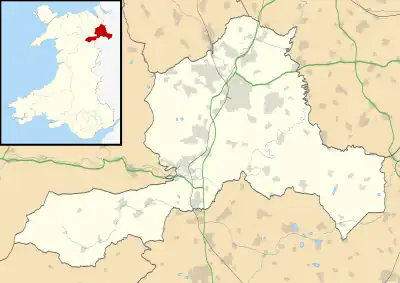| Hightown | |
|---|---|
| Suburb | |
.jpg.webp) Former Green Dragon Hotel on the hillside end of Salop Road, Wrexham. The junction was the area historically known as Wrexham Fechan. | |
 Hightown Location within Wrexham | |
| OS grid reference | SJ 3396449656 |
| Principal area | |
| Preserved county | |
| Country | Wales |
| Sovereign state | United Kingdom |
| Post town | WREXHAM |
| Postcode district | LL13 |
| Dialling code | 01978 |
| Police | North Wales |
| Fire | North Wales |
| Ambulance | Welsh |
| UK Parliament | |
| Senedd Cymru – Welsh Parliament | |
Hightown is a suburban area of Wrexham, in Wrexham County Borough, Wales.[1]
The Wrexham and Ellesmere Railway used to have a station known as Hightown Halt.[2][3] The north-western parts of Hightown towards St Giles' Church near Salop Road were once a separate hamlet called Wrexham Fechan (Fechan meaning 'little' from Welsh) until it was eventually reabsorbed by the then growing town.[4][5][6]
.jpg.webp)
There is a military barracks called Hightown Barracks in the suburb.[7][8]
Until 2011, the suburb was home to the "Hightown Flats", five blocks of five-storey flats built in 1970 of the Napier Square and Gatefield estates.[9][10] The complex contained 181 flats and maisonettes, as well as five bungalows and 26 four-bedroom houses.[11] The flats were known for safety issues, such as poorly lit corridors, and vandalism such as graffiti and abandoned furniture. The area around the complex was associated with antisocial behaviour, arson, and theft. The complex was demolished by Wrexham County Borough Council in 2011 for re-generation,[12] with locals supporting demolition as the only option to regenerate the area.[13]
References
- ↑ "Hightown, Wrexham (Wrecsam)". OS GetOutside. Retrieved 30 April 2022.
- ↑ "Token of rail history goes under the hammer". The Leader. Retrieved 30 April 2022.
- ↑ "Hightown Halt (87088)". Coflein. RCAHMW. Retrieved 22 August 2022.
- ↑ "Map of the town of Wrexham in the townships of Wrexham Regis and Wrexham Abbot in the parish of Wrexham, Denbighshire". Peoples Collection Wales. Retrieved 30 April 2022.
- ↑ "SMALLPOXINWREXHAMFECHANI – Wrexham and Denbighshire Advertiser and Cheshire Shropshire and North Wales Register". George Bayley. 5 November 1864. hdl:10107/4579369. Retrieved 30 April 2022.
- ↑ Irish, Sandra (August 1987). Spatial patterns in the small_town in the nineteenth century – a case study of Wrexham (PDF). University College of Wales, Aberystwyth.
- ↑ Brennan, Shane (4 February 2017). "The army has 'clarified' its plans for one of its North Wales barracks". North Wales Live. Retrieved 30 April 2022.
- ↑ Idris Jones, John (2018). Secret Wrexham. Amberley Publishing. ISBN 9781445677019.
- ↑ "Demolition of Hightown flats in Wrexham going to plan". The Leader. Retrieved 30 April 2022.
- ↑ WalesOnline (22 June 2011). "Wrexham's Hightown flats finally demolished". WalesOnline. Retrieved 30 April 2022.
- ↑ WalesOnline (1 January 2011). "Wrexham's Hightown flats to be demolished". WalesOnline. Retrieved 30 April 2022.
- ↑ "Wrexham's landmark Hightown flats to be demolished". BBC News. 5 January 2011. Retrieved 30 April 2022.
- ↑ Moffitt, Dominic (16 October 2021). "Stunning images show lost Hightown flats in Wrexham through the ages". North Wales Live. Retrieved 30 April 2022.
